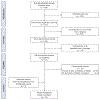Modeling approaches to inform travel-related policies for COVID-19 containment: A scoping review and future directions
- PMID: 38830442
- PMCID: PMC11606784
- DOI: 10.1016/j.tmaid.2024.102730
Modeling approaches to inform travel-related policies for COVID-19 containment: A scoping review and future directions
Abstract
Background: Travel-related strategies to reduce the spread of COVID-19 evolved rapidly in response to changes in the understanding of SARS-CoV-2 and newly available tools for prevention, diagnosis, and treatment. Modeling is an important methodology to investigate the range of outcomes that could occur from different disease containment strategies.
Methods: We examined 43 articles published from December 2019 through September 2022 that used modeling to evaluate travel-related COVID-19 containment strategies. We extracted and synthesized data regarding study objectives, methods, outcomes, populations, settings, strategies, and costs. We used a standardized approach to evaluate each analysis according to 26 criteria for modeling quality and rigor.
Results: The most frequent approaches included compartmental modeling to examine quarantine, isolation, or testing. Early in the pandemic, the goal was to prevent travel-related COVID-19 cases with a focus on individual-level outcomes and assessing strategies such as travel restrictions, quarantine without testing, social distancing, and on-arrival PCR testing. After the development of diagnostic tests and vaccines, modeling studies projected population-level outcomes and investigated these tools to limit COVID-19 spread. Very few published studies included rapid antigen screening strategies, costs, explicit model calibration, or critical evaluation of the modeling approaches.
Conclusion: Future modeling analyses should leverage open-source data, improve the transparency of modeling methods, incorporate newly available prevention, diagnostics, and treatments, and include costs and cost-effectiveness so that modeling analyses can be informative to address future SARS-CoV-2 variants of concern and other emerging infectious diseases (e.g., mpox and Ebola) for travel-related health policies.
Keywords: COVID-19; Decision analysis; Modeling; Public health policies; Travel.
Copyright © 2024 The Authors. Published by Elsevier Ltd.. All rights reserved.
Conflict of interest statement
Declaration of competing interest The authors declare that they have no known competing financial interests or personal relationships that could have appeared to influence the work reported in this paper.
Figures


References
-
- Clifford S, Quilty BJ, Russell TW, Liu Y, Chan Y- WD, Pearson CAB, et al. Strategies to reduce the risk of SARS-CoV-2 importation from international travellers: modelling estimations for the United Kingdom, July 2020. Euro Surveill 2021;26:2001440. 10.2807/1560-7917.ES.2021.26.39.2001440. - DOI - PMC - PubMed
-
- Centers for Disease Control and Prevention. Rescission: Requirement for negative pre-departure COVID-19 test result or documentation of recovery from COVID-19 for all airline or other aircraft passengers arriving into the United States from any foreign country. Centers for Disease Control and Prevention; 2022. https://www.cdc.gov/quarantine/fr-proof-negative-test.html (accessed May 9, 2024).
-
- The World Tourism Organization. COVID-19 related travel restrictions – A global review for tourism. The World Tourism Organization; 2021.
Publication types
MeSH terms
Grants and funding
LinkOut - more resources
Full Text Sources
Medical
Miscellaneous

